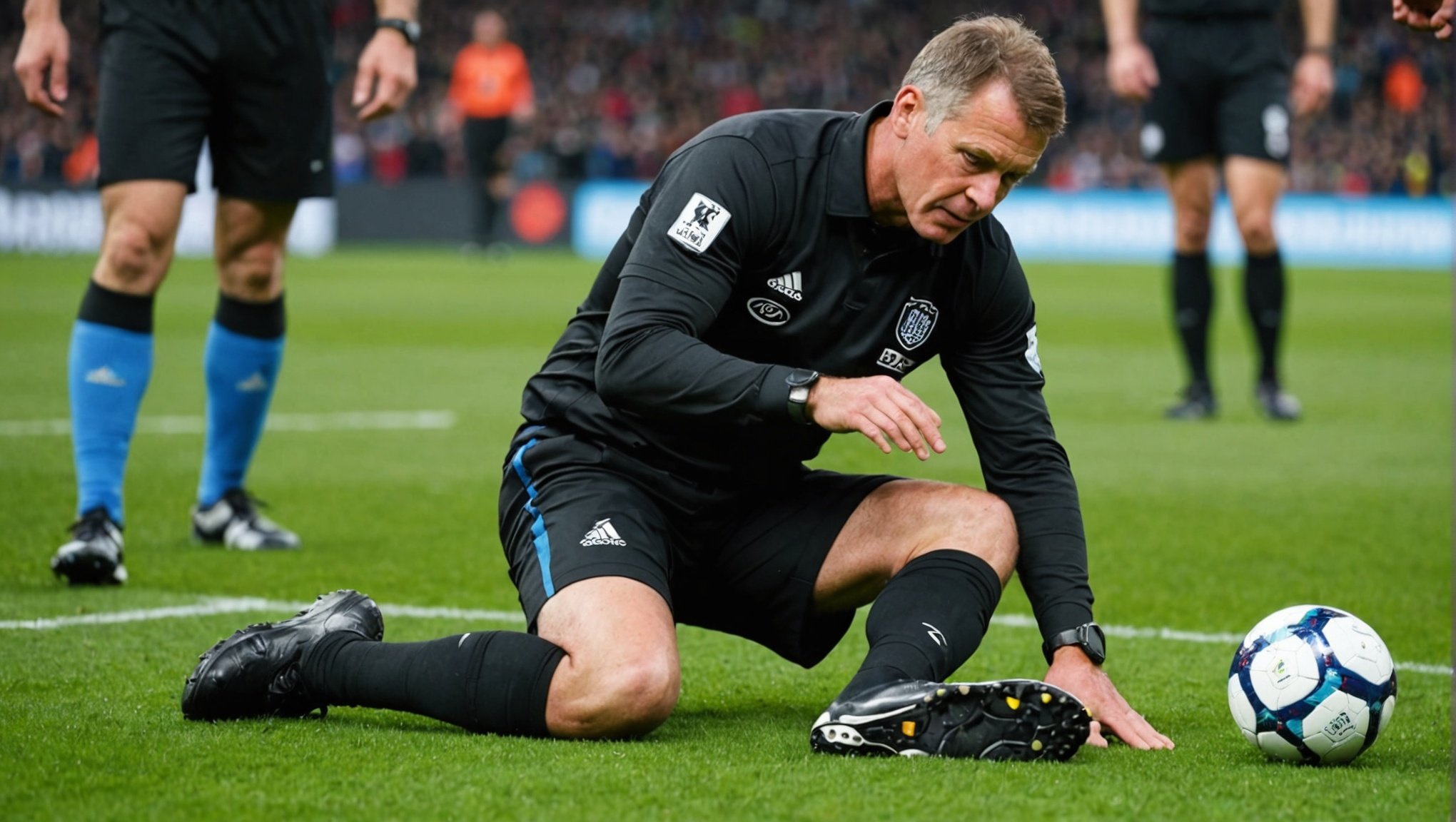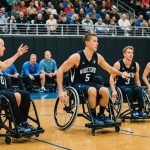Overview of Ankle Injuries in Football
Football referees often face heightened risks of ankle injuries due to the sport’s dynamic nature. Common types of ankle injuries among referees include sprains and strains, typically resulting from rapid pivots or sudden directional changes. These injuries not only cause immediate discomfort but can also lead to long-term mobility issues if not appropriately managed.
Focusing on injury statistics, recent reports from UK football indicate a noticeable incidence of ankle injuries among referees. Data reveals that ankle sprains are particularly prevalent, affecting referees of all experience levels. This emphasis on statistics showcases the need for enhanced preventative measures within the profession.
Topic to read : Essential Mental Readiness Techniques for UK Archers Ahead of Competitions
Ankle injuries significantly impact refereeing performance. A referee battling an injury is likely to face delays in decision-making and may struggle with maintaining position on the field. This reduction in agility and mobility can indirectly affect the accuracy of their calls, influencing the overall flow of a match.
To address these challenges, football associations recommend targeted training routines to help referees strengthen their ankles. These preventative exercises decrease the likelihood of injuries and contribute to improved performance. Therefore, a proactive approach remains crucial in minimizing the occurrence and impact of ankle injuries in football refereeing.
This might interest you : Maximizing Endurance: Essential Nutrition Tips for Long-Distance Swimmers in the UK
Importance of Injury Prevention for Referees
Injury prevention is paramount for maintaining refereeing performance and ensuring the longevity of referees’ careers. Referees must be agile, maintain quick reaction times, and stay physically fit, which can be severely compromised by injuries. When a referee is injured, it not only affects their individual performance but can also jeopardise the outcome of games due to reduced accuracy and slower decision-making capabilities.
The failure to prioritise injury prevention can lead to severe consequences. Beyond the physical pain and recovery time, there is the risk of diminished career lifespan and the potential loss of income from missed matches. Furthermore, recurring injuries increase the likelihood of chronic health issues, which can have long-term implications on a referee’s quality of life.
Referees play a crucial role in upholding the integrity and safety of games. A physically compromised referee may struggle to enforce rules effectively, which could potentially lead to unsafe play and endanger the safety of players. Prioritising injury prevention not only benefits the referee’s health but also ensures the smooth functioning and fairness of the sport. Therefore, adopting a proactive approach towards injury prevention is essential in sustaining both personal and professional health benefits for referees.
Effective Techniques to Prevent Ankle Injuries
Preventing ankle injuries is crucial for maintaining performance, especially in demanding activities like football refereeing. Incorporating injury prevention techniques into your routine can significantly reduce the risk of sprains and strains.
Begin with strengthening exercises specific to ankle support. Focus on strength training exercises like calf raises and ankle dorsiflexion. These help build the muscles around the ankle, providing better stability and reducing the likelihood of injury.
Balance and flexibility training are equally important. Include exercises such as single-leg stands and yoga stretches to improve joint range of motion and proprioception. Enhanced balance can better equip referees to navigate quick directional changes on the field.
A well-considered warm-up routine complements these exercises. Start with dynamic stretches, including leg swings and heel walks. Tailored for football refereeing, this prepares the body for intense activity and increases blood flow to critical muscles.
Integrating these techniques into your regular fitness plan provides comprehensive ankle support. This approach not only guards against injuries but also enhances overall performance and endurance in your role as a referee.
Footwear Recommendations for Referees
When selecting referee footwear, prioritising the right features can significantly impact performance and injury prevention. One crucial aspect to consider is ankle support. The demands of officiating require quick movements and lateral shifts, making proper shoes essential in preventing strains and sprains.
Referees should look for shoes with ample cushioning, robust support, and a snug fit. This helps absorb impact and reduce fatigue over extended periods on the field. Footwear with enhanced traction is also beneficial, ensuring stability across various playing surfaces.
Injury prevention is greatly influenced by the quality of your footwear. Proper shoes help maintain correct foot alignment, distribute stress evenly, and provide necessary shock absorption. This is particularly important for referees who face high demands on their feet and joints during games.
Among UK referees, some brands stand out for their comfort and durability. Styles like the Nike Tiempo and Adidas Copa are favoured for their ankle support and ergonomic design. These models often feature lightweight materials, ensuring minimal encumbrance while officiating.
Selecting the appropriate referee footwear is not merely a matter of comfort but essential to your overall health and performance. By investing in shoes with these key features, referees can reduce the risk of injury and maintain optimal function during every match.
Utilization of Supportive Gear
When it comes to safeguarding your body in sports, supportive gear like ankle braces can make a significant difference. These protective equipment come in various forms, each designed for specific injury prevention needs. Whether you opt for lace-up, hinged, or strap braces, understanding their effectiveness in different scenarios is crucial.
Ankle braces are renowned for offering stability, reducing the risk of sprains, and even providing post-injury support. But, how do you know which one is right for you? Lace-up braces provide a snug fit, ideal for those seeking maximum support. Hinged braces offer flexibility, which is beneficial for sports requiring rapid movements. Strap braces are adjustable, allowing for a customizable fit based on activity intensity.
Proper usage of supportive gear can prevent injuries before they occur. It’s important to wear them during training and matches, especially if you have a history of ankle injuries. Ensuring a correct fit and secure fastening can enhance their effectiveness significantly.
Many referees have shared positive testimonials about their experiences with such equipment. Not only do they feel more secure, but they also report less discomfort during prolonged periods of movement, making a compelling case for the integration of such gear on the field.
Role of Pre-Match Training and Conditioning
Before stepping onto the field, a comprehensive Pre-Match Training plan can be a game-changer for referees. Tailoring a conditioning program specifically for referees is crucial, as their roles demand unique physical and mental stamina. Incorporating exercises that focus on cardiovascular fitness, agility, and endurance during pre-match training routines not only helps in maintaining these qualities but can bolster injury preparedness.
Central to these routines are dynamic warm-ups and cool-down activities, which facilitate muscle flexibility and minimise the risk of injuries. Engaging in high-intensity interval training (HIIT) also aids in building the explosiveness necessary for sprinting across the field. Furthermore, mental conditioning, including concentration drills and stress management techniques, ensures referees remain focused and composed under pressure.
Referees who have embraced such tailored conditioning programs often report a noticeable improvement in their on-field performance. Success stories abound of individuals who, after intensifying their pre-match training efforts, have achieved higher levels of physical resilience and decision-making accuracy. This transformation highlights the profound impact a disciplined and purpose-built conditioning regimen can have on a referee’s career.
Recovery Strategies After Matches
Recovery techniques are vital for maintaining long-term athletic performance and minimising injury risk. Focusing on post-match care ensures athletes can continue performing at their peak. Key elements include proper cooldown routines and stretching. These steps not only aid in muscle relaxation but also improve flexibility and reduce soreness.
Cooldown routines might involve light jogging or walking, which helps gradually bring the heart rate down. Incorporating dynamic stretches further benefits muscle elasticity. This combination facilitates effective injury rehabilitation and keeps muscles primed for future exertion.
Addressing potential injuries, especially concerning an ankle, is crucial. Swift intervention prevents further damage. Following an injury, initial management steps involve the R.I.C.E method: Rest, Ice, Compression, and Elevation. Resting prevents exacerbating the injury. Applying ice reduces swelling, while compression supports the joint. Elevation minimises fluid accumulation.
Implementing these strategies significantly contributes to reducing the risk of future injuries. Hence, diligent attention to these recovery aspects is essential for athletes to balance between competitiveness and wellbeing, ultimately enhancing their overall career longevity.
Continuing Education and Workshops
In the world of sports, referee education plays a vital role in maintaining a high standard of officiating and ensuring the safety of all participants. Through ongoing workshops, referees are exposed to the newest strategies and methodologies, equipping them with the tools necessary to handle real-game situations effectively.
One key aspect of these educational initiatives is injury prevention training. With the physical demands placed on referees, particularly in high-intensity sports environments, understanding how to prevent common injuries is crucial. Workshops focused on injury prevention provide referees with practical advice, from understanding proper biomechanical movements to executing emergency protocols effectively.
These workshops often include case studies highlighting the experiences of referees who have benefited from continuous education. For instance, there are numerous accounts of referees who, through targeted training, noticed a substantial decrease in injuries sustained during matches. One referee cited increased stamina and reduced knee strain, attributing these improvements to the applied techniques learned during a workshop.
By participating in these structured education sessions, referees can stay ahead of the curve and mitigate risks, ensuring a safe and fair environment for athletes and themselves.






